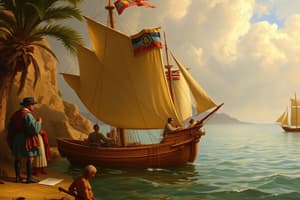Podcast
Questions and Answers
Who was Antonio Pigafetta?
Who was Antonio Pigafetta?
A Venetian scholar and explorer who traveled with Ferdinand Magellan.
What was the primary measure of wealth in the 16th century European economy?
What was the primary measure of wealth in the 16th century European economy?
- Land ownership
- Investments
- Accrual of precious metals (correct)
- Trading spices
Spain and Portugal never competed for dominance in exploration.
Spain and Portugal never competed for dominance in exploration.
False (B)
How many men returned to Spain from Magellan's voyage?
How many men returned to Spain from Magellan's voyage?
What alternative route did Portugal explore to reach the Spice Islands?
What alternative route did Portugal explore to reach the Spice Islands?
The Pope was asked to __________ the New World between Spain and Portugal.
The Pope was asked to __________ the New World between Spain and Portugal.
What are two key details about the women described by Pigafetta?
What are two key details about the women described by Pigafetta?
Match the following ancestors with their titles:
Match the following ancestors with their titles:
Study Notes
Historical Context
- Intense competition between Spain and Portugal over New World territories prompted intervention from the pope to divide the land.
- The 16th century European economy was based on mercantilism, emphasizing the accumulation of precious metals.
Antonio Pigafetta
- Venetian scholar and chronicler who accompanied Ferdinand Magellan on his expedition.
- Documented Magellan's voyage, providing crucial historical insights.
- Out of approximately 240 crew members, only 18, including Pigafetta, returned to Spain in 1522.
Encounter with Early Ancestors
- Descriptions of indigenous people highlight diversity in appearance, clothing, and practices.
- Men depicted as tattooed, some adorned with gold jewelry and wearing clothing made from bark.
- Anointed bodies with coconut oil offered protection against the elements.
Food and Diet
- Indigenous peoples consumed staples like rice (umay), coconut, and fish.
- Traditional beverage included uraca, a palm wine.
- Animal husbandry prevalent with swine, fowls, and goats among domesticated animals.
Dwellings and Architecture
- Houses constructed on large wooden posts, thatched with palm and fig leaves, elevating them from the ground.
Gender Roles and Practices
- Women described as large, with distinctive long black hair, adorned with gold earrings.
- Cultural practices included tooth and ear ornamentation and the gradual opening of vaginas for young females.
Key Figures
- Raia Humabon: Local chief, notable historical figure in the context of early Spanish colonization.
- His son, Fernando, and Queen Johanna, represent significant figures in local governance and social structure.
- Presence of royal figures denotes complexity in local leadership systems.
Historical Relevance
- Pigafetta's writings serve as vital primary sources for understanding the interactions between European explorers and indigenous communities.
- Documented cultural habits and lifestyles contribute to the broader understanding of Philippine history.
Studying That Suits You
Use AI to generate personalized quizzes and flashcards to suit your learning preferences.
Description
This quiz explores the historical context of European exploration in the 16th century, focusing on the competition between Spain and Portugal as well as the insights provided by Antonio Pigafetta. It also examines the diverse cultures of indigenous peoples encountered during these voyages, including their diet and social practices.




